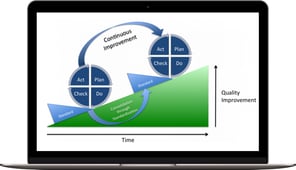 While Lean got its start in the manufacturing industry, people have found that the broader context of a Lean adoption strategy is relevant to all industries and sectors. That said, the public education system is a great place to start—and the Des Moines Public School District has the results to prove it.
While Lean got its start in the manufacturing industry, people have found that the broader context of a Lean adoption strategy is relevant to all industries and sectors. That said, the public education system is a great place to start—and the Des Moines Public School District has the results to prove it.
This is what Harry Kenworthy, Principal of the Quality and Productivity Improvement Center (QPIC), told KaiNexus in a recent webinar.
Des Moines Public Schools began working with QPIC in April 2015, and the district has since completed 363 lean projects. They are now in a self-sustaining lean deployment mode from which other organizations can learn a great deal.
Watch the webinar now:
How a Lean Adoption Strategy for Public Schools Applies to Everyone
Presented by Harry Kenworthy
In this webinar, you will learn:
- Why Lean fails too often
- Why organizational “knowledge” undermines Lean
- When and how leadership should be engaged
- A “Proven Path” strategy for launching a Lean initiative; how two weeks
means all the difference for success
How to Avoid a Lean Deployment Failure
Introducing a Lean strategy means introducing a major change. Far too often, team members assume it’s easy—but the assumption that lean is simple often leads to failure.
Kenworthy suggests that organizations do the following to avoid failure in their deployment of a Lean strategy. These suggestions are based on Dr. John Kotter’s change management research at Harvard University:
- Establish a sense of urgency to keep senior leadership involved in the Lean deployment process
- Create a guiding coalition to drive commitment to training and weed out people who are resisting change
- Develop a vision and strategy to reinforce that lean is strategic in nature, and that the organization’s focus should be on training rather than improvement
- Communicate the change vision to ensure both upper and lower levels of the organization are committed to the continuous improvement process
- Empower employees to take broad-based action by providing project support and tracking systems
- Generate short-term wins to consistently meet objectives without launching too many projects at once
- Consolidate gains to develop internal experts and track results via metrics
- Anchor the new approaches in the culture by linking them to lean activities
Anchoring the new approaches in the culture is especially important. According to True North thinking, continuous improvement is 15-20% tools and 80-85% maintaining and sustaining the organizational culture.
How Can Your Organization Deploy a Lean Strategy?
Those heading the Lean rollout should select approximately 20 Lean stewards, who can then establish a steering committee in charge of Lean trainings, standard work activities, and coming up an initiative name.
Note that it’s best to avoid using the word “program” in your initiative name, which implies a short duration. Des Moines Public Schools, for instance, named their initiative “DMPS Continuous Improvement.”
The next step involves the development of an elevator pitch, which will ensure everyone understands the purpose of the Lean strategy. The elevator speech should address these four questions.
- What are we doing?
- Why are we doing it?
- What do you expect out of us?
- What’s in it for us?
Above all, an effective Lean adoption strategy should teach everyone in the organization how to solve problems and help remove lean wastes such as wait times and inventory. For the full scoop on how to deploy a seamless lean adoption strategy, view our webinar with Kenworthy here.

![[Watch Now] How Lean in Public Schools Applies to Everyone](https://no-cache.hubspot.com/cta/default/326641/38932f80-87a7-478e-a223-940928058374.png)


Add a Comment